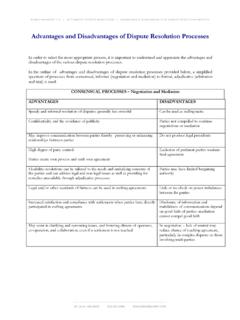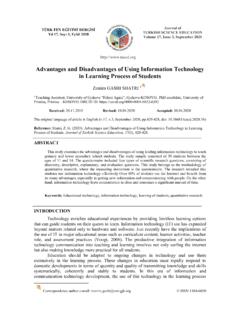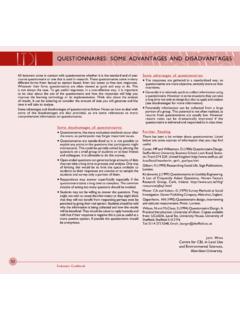Transcription of Advantages and Disadvantages of Using e-Learning in ...
1 ISSN 1479-4403 107 ACPIL Reference this paper: Al Rawashdeh, A. Z., et al., 2021. Advantages and Disadvantages of Using e-Learning in University Education: Analyzing Students Perspectives. The Electronic Journal of e-Learning , 19(2), pp. 107-117, available online at Advantages and Disadvantages of Using e-Learning in University Education: Analyzing Students Perspectives Alaa Zuhir Al Rawashdeh1,2, Enaam Youssef Mohammed1, 3, Asma Rebhi Al Arab1, Mahmoud Alara4 and Butheyna Al-Rawashdeh2 1 Ajman University, Ajman, UAE 2Al Balqaa Applied University, Jordan 3 Ain-Shams University, Egypt 4 Clemson University, USA Abstract.
2 The architecture of a learning system implies a heavy task for e-Learning to be integrated into a complicated system that is flexible, time scalable, and capable of lasting, even though there are many diverse tools. Currently, higher education in United Arab Emirates is experiencing a major transformation, considering increased accessibility. Therefore, the study aims to identify the Advantages and Disadvantages of e-Learning in university education in United Arab Emirates. A descriptive study design was used to randomly select students from Ajman university, who were enrolled in 2018/2019 academic year.
3 A close-ended structured questionnaire was constructed to collect data from students. Frequencies and percentages were used to analyse the data collected. 81% students stated that e-Learning provides scientific material in an interesting way. Similarly, 80% students have responded that e-Learning increases the possibility of contact between students among themselves and between the students and the teacher. 73% students indicated that due to increasing social isolation, they spend more time in front of the technical means of social interaction account and face-to-face with others.
4 70% students have indicated that there is a presence of electronic illiteracy among parents, which reduces their ability to follow their children electronically. It is essential for potential e-learners to understand the differences between an e-Learning classroom setting and a conventional classroom setting as there are both Advantages and Disadvantages of e-Learning to both environments that can probably influence their overall performance as a student. Keywords: Advantages , Disadvantages , e-Learning , University Education 1. Introduction Electronic learning or e-Learning is used to offer instructional programs to distant learners (Arkorful and Abaidoo, 2015).
5 It is an online learning platform that emerges in a formal context and utilizes a variety of multimedia technologies. Electronic hardware and software support this system either offline or online. A personal computer is usually used for delivering training or computer-enhanced learning related to e-Learning (Samsuri, Nadzri and Rom, 2014). Other communication technologies deliver learning based on tutorials, learning support systems, and online lectures (Kattoua, Al-Lozi and Alrowwad, 2016). It is based on technology for improving classroom engagement through positive environment, where students are deliberately engaged in online tutorials for completing a task assigned to them.
6 e-Learning ensures that students are completely involved as learning takes place together with texts, videos, sounds, collaborative sharing, and interactive graphics. It may enhance the quality of teaching and learning, report the need for higher institutions for maintaining competitive advantage , and access to education and training in this globalizing marketplace for students (Islam, Beer and Slack, 2015). The integration of information technology (IT) in the form of e-Learning has resulted in the reduction of students cost while improving the quality of learning and teaching (Songkram, 2015).
7 This shows that e-Learning can be economical for students Using it, and they can perform other useful activities in their spare time (Aparicio, Bacao and Oliveira, 2016). Flexibility is another major advantage of e-Learning as it provides learners the benefit to take classes anywhere and anytime. Furthermore, e-Learning cater different types and varieties of learning approaches by utilizing much interactive content available on the internet (Songkram et al., 2015). The accessibility of technology and The Electronic Journal of e-Learning Volume 19 Issue 3 2021 108 ACPIL wide nature of the internet have generated a surge in the need for web-based learning and teaching.
8 Distance learning is an increasingly expanding environment, which enable users the flexibility to operate outside the barriers of place and time. In university education, online learning is explained as learning that takes place completely or partially over the internet (Gilbert, 2015). Online learning is beneficial to a number of learners and appears as more common in settings from elementary schools to high schools and into post-secondary education. The role of engagement in e-Learning is important for effective learning as it is not merely student-student interaction that matters.
9 There are six different forms of engagement that can be identified in distance learning education: (1) teacher-content (2) content-content (3) student-teacher (4) student-student (5) teacher-teacher and (6) student-content (Talebian, Mohammadi and Rezvanfar, 2014). Theories that encourage adoption of new technologies in the learning process are based on the postulation that students are active participants who pursue and create knowledge throughout a meaningful context. Different means of collaborative tools can be used for communication and collaborative learning (Sarkar, 2012).
10 The architecture of a learning system implies a heavy task for e-Learning to be integrated into a complicated system that is flexible, time scalable, and capable of lasting, even though there are many diverse tools. The learning space is left under the control of the instructors and institutions Using conventional learning management system (LMS) irrespective of any external tools (Sarrab, Al-Shihi and Rehman, 2013). In particular, this leaves minimal space for learners to organize their digital learning space and to carry-forward their activities. Currently, higher education in United Arab Emirates is experiencing a major transformation, considering increased accessibility.

















